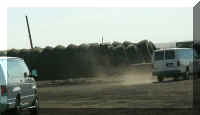
Alaska 2005 - Our Journey Home . . . Page 2
Updated: 11/30/08
On this page . . .
Badlands National Park, South Dakota
(Includes: Prairie Homestead)
Corn Palace - Mitchell, South Dakota
A tour of the Black Thunder Coal Mine was not part of the HitchHiker rally. The tour of a local coal mine arranged by the visitors center stopped for the season on August 31. We heard that another group had toured the Black Thunder mine a few days earlier. When Rex heard that a second group had arranged a tour and had room for four more people, he signed us up. After the continental breakfast and saying 'good-bye' to friends, we headed out to the mine.
After a video orientation on the operation of a strip coal mine, we put on our hard hats and climbed aboard three vans. As the vans drove past an old tire storage area, you immediately became aware that all the equipment is huge. And, that this was a dusty place.
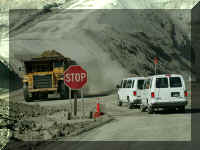
And, that the big trucks
had the right of way.
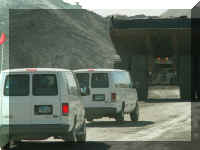
And, sometimes follow patiently ...
We drove through where they were storing dirt and top soil for the reclamation stage of the operation. They have significant responsibilities to return the land to the same condition it was before the mining began.
We headed for a viewing stand overlooking one of the coal operations. Keith, the engineer who traveled with us and Don, our driver, were great tour guides. Keith explained that the Black Thunder produces nearly three tons of coal per second - 24 hours a day, 365 days a year. The mine provides 9% of USA coal - which is used to produce 7% of USA electrical energy. The reserve is estimated to be 800 million tons of coal.
Because of the dust in the air and the distance to the actual operation, we could barely see the equipment.
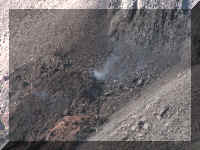
Spontaneous fires are common.
Caused by coal dust and water...
The trucks were busy. It takes a truck about a half-hour to make the trip from the dragline to the crushers. That is an hour for each round trip.
The white trucks are the SMALL ones and the yellow ones are the BIG trucks.
That is what Don told us. They are both BIG.
The next stop for the vans was in the area where the dragline was working. It is huge like everything else in the mine. It only moves the 'overburden' from the top of the coal. The overburden can be fifty to two hundred and fifty feet deep. This particular dragline weighs 14.7 million pounds, is 238 feet tall, and has a bucket that can carry up to 164 cubic yards of material. It can dig the equivalent of an Olympic-sized swimming pool in 25 minutes.
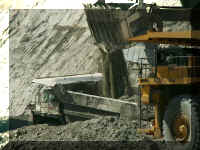 The
overburden is moved from on top of the new coal seam to fill the space where the
prior seam was located. So, the dragline moves back and forth exposing a new
coal seam with each pass.
The
overburden is moved from on top of the new coal seam to fill the space where the
prior seam was located. So, the dragline moves back and forth exposing a new
coal seam with each pass.
However, the top soil and some dirt must be trucked out to the storage area.
Our van got separated from the other two and ended up on top of a coal seam - the overburden had been removed.
We stopped by the crushers after our drive on the coal seam.
The trucks are guided by a GPS-enhanced dispatch system. The lights indicate the available crusher. The coal is crushed from lumps of coal up to five feet thick to pieces of coal about two inches in size. These crushers can process a 240-ton truckload in about five minutes.
The trucks dump the lumps of coal into the top of the crusher. The crushed coal is picked up at the bottom of the crusher and carried by conveyor to the loadout building for loading into railroad coal cars.
The conveyors move coal a long distance including over and under roads.
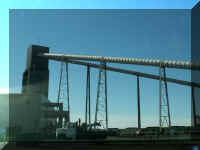 The
conveyors end at the loadout building that loads the railcars. An entire train can be
loaded in one hour and fifteen minutes. The railcars are pulled into the
building and loaded with the exact amount of coal per car.
The
conveyors end at the loadout building that loads the railcars. An entire train can be
loaded in one hour and fifteen minutes. The railcars are pulled into the
building and loaded with the exact amount of coal per car.
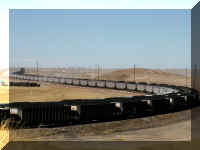
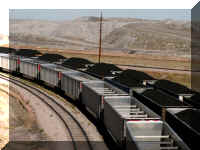
The mine loads 24 to 26 trains a day - 120 to 150 cars per train - more than 25
miles for rail cars. Each train
carries more than 14,000 tons of coal.
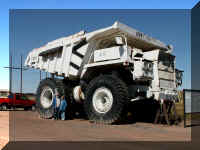 The
following photographs will give you some idea of the size of the trucks and
other equipment. Can you find us in the first photograph?
The
following photographs will give you some idea of the size of the trucks and
other equipment. Can you find us in the first photograph?
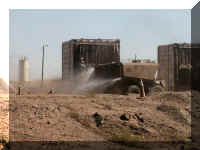 The
dust you see in the above photograph would be much worse if not for the
continued watering of the roads.
The
dust you see in the above photograph would be much worse if not for the
continued watering of the roads.
This is quite the truck garage area. Some of the trucks hold 55 gallons of oil. Others use oil recovery systems where the old oil is burned as fuel. Yes, an oil change includes a truck wash.
We had a great tour of the coal mine. As you could see, we were down in the mine observing the actual operations in progress. It was well worth the four hours including travel time.
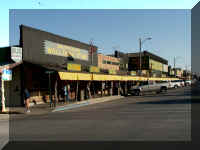 Our next stop was at
Wall Drugs in South Dakota. You can not travel any road in
the area without seeing sign directing you to visit Wall Drugs. We were there 35
years ago - during that time it has really changed. We remember a smaller
store, sort of by itself. While our memory may be a little off, it was nothing
like what we saw on our first visit. Wall Drugs now covers an entire square block. It
employs a third of the town's 813 people.
Our next stop was at
Wall Drugs in South Dakota. You can not travel any road in
the area without seeing sign directing you to visit Wall Drugs. We were there 35
years ago - during that time it has really changed. We remember a smaller
store, sort of by itself. While our memory may be a little off, it was nothing
like what we saw on our first visit. Wall Drugs now covers an entire square block. It
employs a third of the town's 813 people.
During the Depression in 1931, Ted Hustead used free ice water to attract the traveling public to the store. The idea saved the drug store from going out of business. In 1936, he started road side advertising across the country - the federal 1965 Highway Beautification Act forced the removal of most of the signs.
The ice water continues to be free today.
The buildings include mini-malls of shops. These stuffed animals where displayed at the end of this mini-mall.
Some signs along the road said 'don't miss the backyard' at Wall drugs. The backyard included a lot of historical documents where Wall Drugs was mentioned - photographs, newspapers and magazines. You could look at displays of western figures and it offered many opportunities for the tourists to shop. There are also restaurants/cafes for meals.
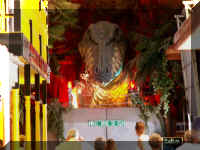 And,
every fifteen minutes a dragon roared to entertain the kids.
And,
every fifteen minutes a dragon roared to entertain the kids.
Outside, there were other attractions of interest to children of all ages.
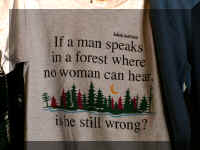 We
did not but any, but several t-shirts brought chuckles to people as they walked
by. As we were reading this one, a man walked by and said,
"Yes".
We
did not but any, but several t-shirts brought chuckles to people as they walked
by. As we were reading this one, a man walked by and said,
"Yes".
There is no admission charge. You can walk around and enjoy the many displays without spending any money. However, we had to buy an ice cream cone at Wall Drugs. You could spend hours looking at all that is there.
Badlands National Park is just outside Wall, South Dakota. It was also a little different than we remembered. They did not change - it was our memory of the visit 35 years ago that had faded. We remembered looking at the Badlands from the several overlooks - we did not remember driving in the Badlands terrain as we did this visit. This trip, we touched and walked on the rough terrain.
We have posted the Badlands National Park - 2005 as a separate page on our Web site because it is a page that may be of interest to people looking only at national parks. That page also includes our visit to the Prairie Homestead located just outside the east end of the park.
Corn Palace - Mitchell, South Dakota In 1892, the first Corn Palace was created to showcase all of the crops that could be grown in the rich Dakota soil. It was replaced in 1905 with a larger building, both buildings were wooden structures with dirt floors and no electricity. In 1921, due to changes in public safety laws, the present Corn Palace was build of steel and brick. It is affectionately call the 'worlds largest bird feeder'.
The Corn Palace is decorated with 13 colors of corn, grasses and grains grown on a local 100 acre farm. It displays the varieties of crops grown within a 30 mile radius of the Corn Palace.
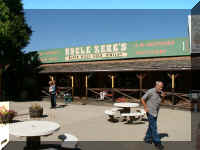 We
did not remember the commercialization of the area around the Corn Palace. A
display in this mall across the street shows a mural of a duck - in the partial
tar paper (black roofing paper) stage and the finished mural. The base for the
lamp posts confirms the importance of corn to the area.
We
did not remember the commercialization of the area around the Corn Palace. A
display in this mall across the street shows a mural of a duck - in the partial
tar paper (black roofing paper) stage and the finished mural. The base for the
lamp posts confirms the importance of corn to the area.
Late fall is when the new design is applied to the building. On the side of the building is an in-process design - tar paper and some corn.
Workers cut and place the corn according to the design and color of corn called for on the tar paper. Each year, 275,00 ears of corn are cut lengthwise, cut to length and nailed to the building. It is a very large 'corn-by-number' project.
The marquee on the front the building announces the "Salute to Rodeo 2006". It has not been covered with corn yet.
The 2006 rodeo theme is complete on several murals.
The inside of the Corn Palace is open to visitors. It includes a small gift area, a snack bar, historical displays and dispalys of local interest. Side hallways show the designs from each year the Corn Palace has been in existence. This framed photograph is from 1971 - our prior visit.
The inside of the Corn Palace is used for industrial exhibits, stage shows, banquets, dances, graduations, events of civic interest, basketball arena. Yes, there are pictures created with corn on the inside too!
Allow at least an hour to visit the Corn Palace. Admission is free - there is a donation box in the lobby. Be sure an go inside if it is open (8am - 5pm M-F, longer during the tourist season) to see the multi-purpose room and the information displayed inside.
This is the final attraction of our Alaska 2005 Journey Home.
After spending a few days at Fred and Becky's, we will drive to Michigan.
We hope you have enjoyed our journal and the photographs of our Alaskan Adventure.
Fred and Mary Lou
Go back to Alaska Photo Album .